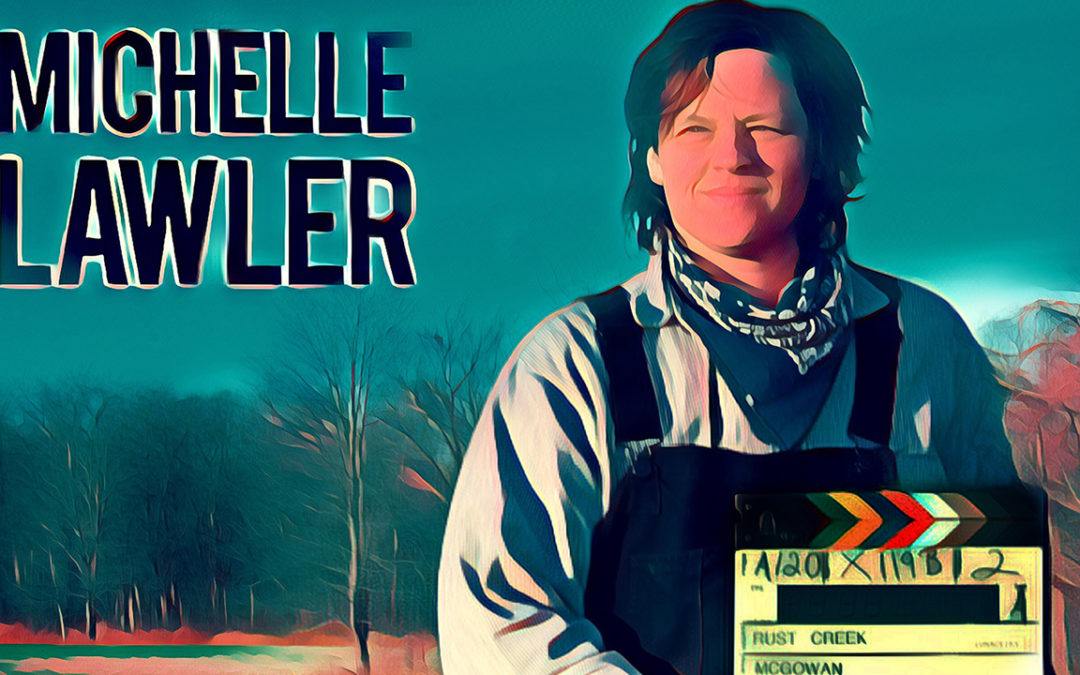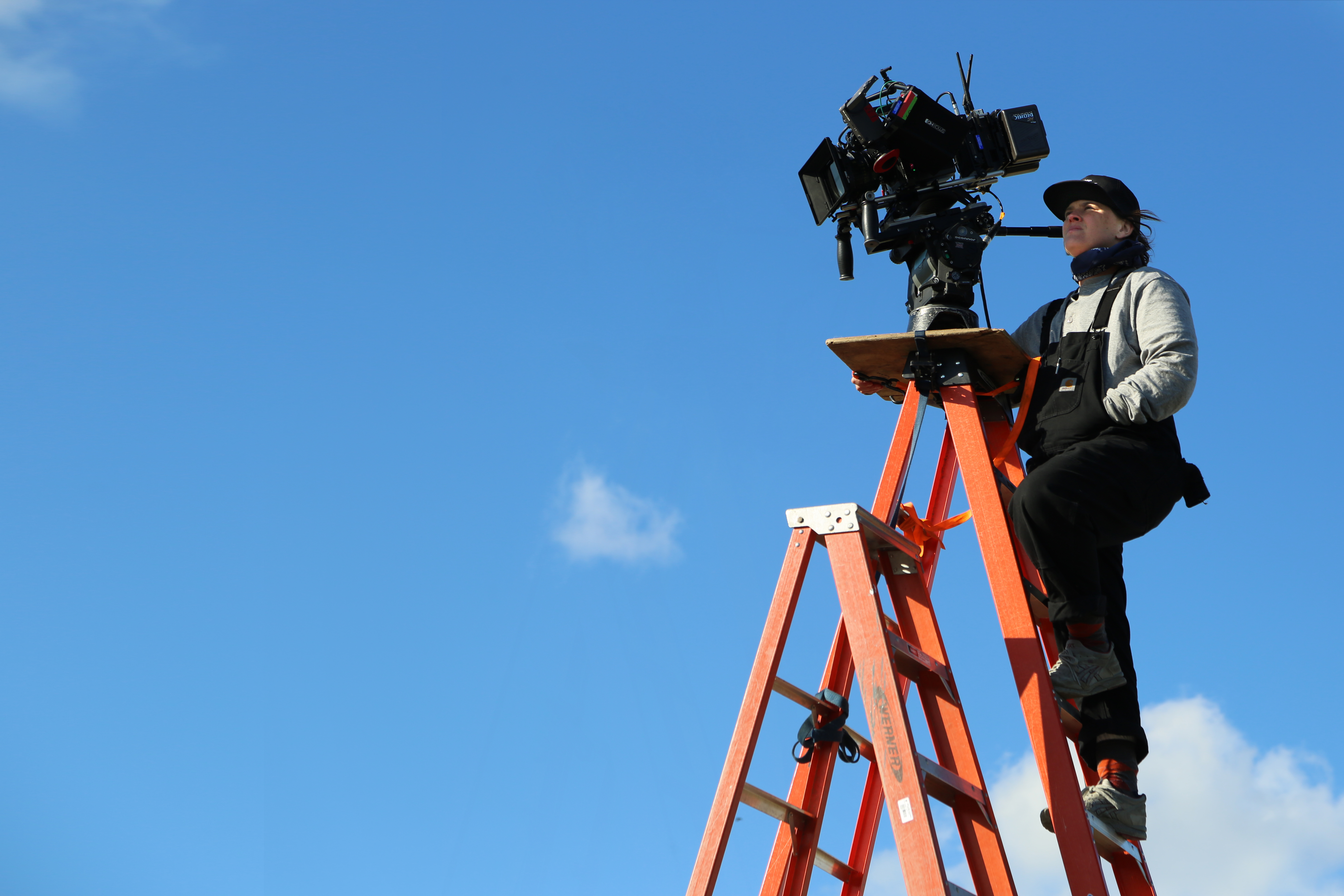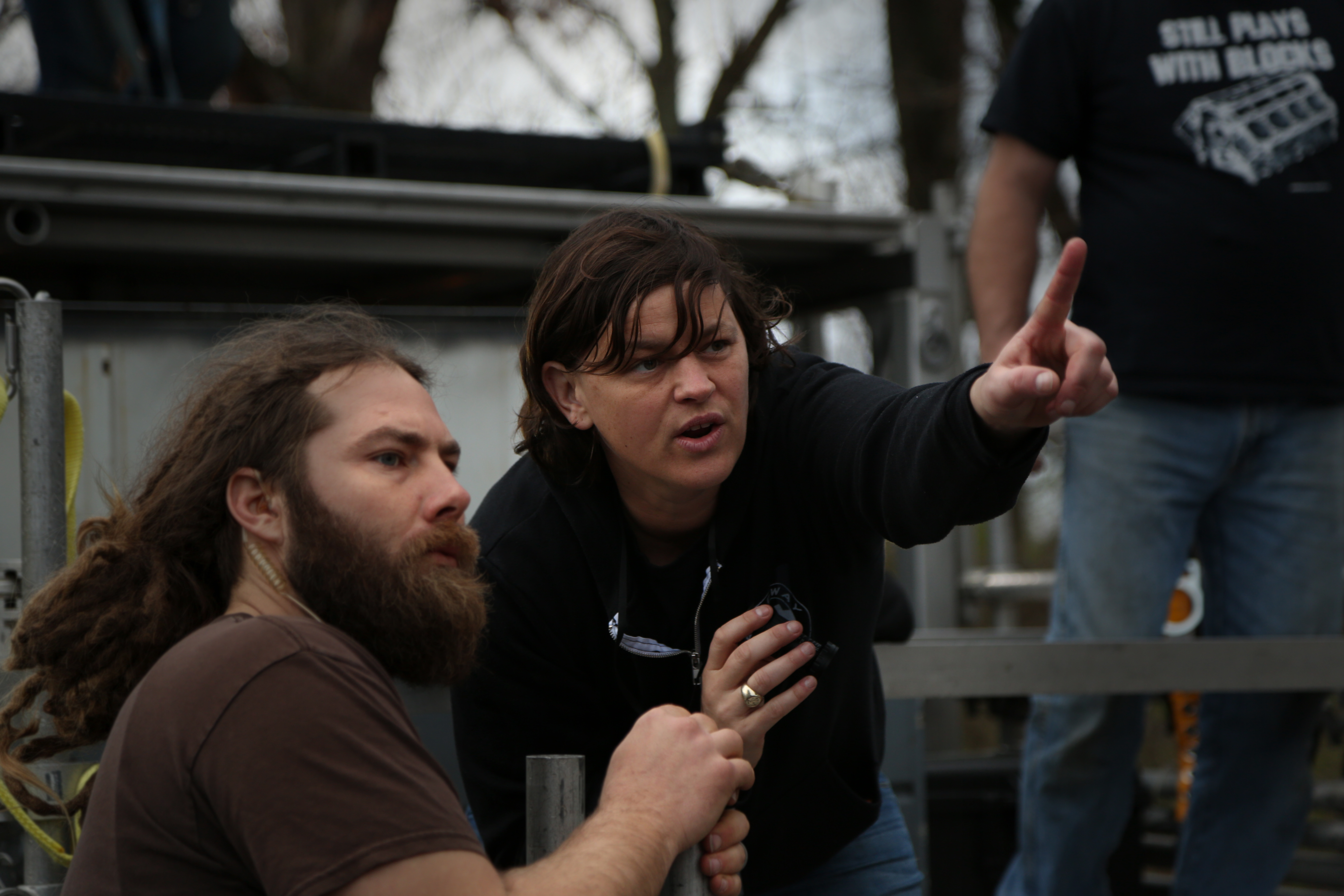About Michelle Lawler
Michelle Lawler is a Los Angeles based cinematographer. She is a graduate of San Francisco State University and the American Film Institute, and a Cinematography Fellow at Film Independent. Her feature documentary, Forever’s Gonna Start Tonight, won numerous audience awards including Outfest LA 2010. She has also lensed episodes of Jill Soloway’s Transparent and Lena Waithe’s Boomerang.
Her latest feature film is Lunacy Productions’ Rust Creek, available in select theatres and on VOD platforms everywhere! She also recently shot the Kyra Sedgwick / Ali Liebegott collaboration Girls Weekend, which premieres this week at the Sundance Film Festival. The Lunacy Productions Blog caught up with Michelle in Park City to talk more about her career and her latest projects.
Lunacy Productions: How did you get interested in cinematography?
Michelle Lawler: I got into cinematography because I was shooting a bunch of live concerts. My girlfriend at the time was in a band, and I went on tour with them as their roadie. I brought a bunch of Super 8 film with me and shot all the shows, but when I came back and got the film developed, it was all black. None of it came out!
I was like, “Oh, man.” I started taking film classes and camera assisting. I gaffed, I gripped. I did everything I could to learn, and then eventually decided that I wanted to be a DP. I shot a bunch of documentaries. I moved to LA, attended AFI and got my master’s in cinematography. The rest is history (or herstory).
LP: Was there a specific moment when you realized you didn’t want to do anything else?
ML: The first film I made was a feature length documentary called Forever’s Going to Start Tonight. It was about this woman Vicki Marlane who is a 71-year-old transgender drag performer in San Francisco. She had been performing since the 1920s. She had an incredible life story.
When I saw her perform, I was just really blown away by her. I was like, “Wow, she’s 71! How much has the world changed since she started doing this?” After a couple years of thinking that her life story would be a really interesting film, I approached her and asked if I could make a documentary about her. She said, “Yes.” We followed her around for just two days, but the footage that we got was just solid gold. The movie played all over the world. It won tons of awards.
She’s 71 in the movie. By the time it was out and screening, she was like 75. For her to be working in tiny drag clubs her whole life, and then all of a sudden be in front of audiences of hundreds of people and get standing ovations, that was really beautiful to watch and experience.
Making Forever’s Going to Start Tonight really hooked me into what was possible visually and emotionally, and how personally rewarding it can be.
LP: How many years did you spend in documentary, and how, and why, did you make the transition to narrative?
ML: I studied documentary at San Francisco State University during undergrad. That’s a big documentary school. I worked on anything I could. There was only so high you could go in the film industry in San Francisco at that time (around 2003).
I also worked for HGTV. I did everything I could to learn. I had crewed on some non-union features that actually were pretty successful. I really wanted to learn how to light a scene and how to frame something to give a certain emotion. I feel like those techniques are really hard to learn unless you’re doing it.
You can read about it, and you can be around it, but you really just need to do it, and just keep doing it until you figure it out. Lighting is totally something you have to feel.
Michelle Lawler prepares the camera for a critical effects shot on the set of Rust Creek.
As a woman, I found it really hard to find a mentor that would teach me. There were a bunch of gaffers that I worked for, but they did not take me seriously at all. It’s 2019, so this was like 16 years ago, but so much has changed in the industry in the past 16 years. There was no talk of championing women. That just wasn’t part of the conversation.
I remember there was this gaffer I gripped for in San Francisco: I was working for free, didn’t really know what I was doing, but he wouldn’t even look at me. He didn’t even think I could carry a few stands. It was that kind of sh**. I knew I just had to take it in my own hands and get out of San Francisco, come to LA and really immerse myself in cinematography.
LP: How did you overcome those types of challenges? If you were to give some advice to up-and-coming female filmmakers now, thinking about yourself in that time and what you went through, what would you say?
ML: I think it’s really important early on to find your people, because those are the people that you’re going to come up with. As you all get opportunities, you can give each other opportunities and come up together. I’m at the point in my career where a lot of my friends who I’ve come up with over the past 20 years are all starting to get their breaks. They’re shooting really big movies, or their TV shows are getting greenlit.
You have to be really open to different kinds of people too because you never know who’s going to be that person to make some pretty incredible films. Don’t be too judgmental of people and be really open to different work experiences.
You also have to keep at it. You can’t give up. It is very thankless at first. You’re working for no money. You’re volunteering. Nobody gives you the time of day. If you keep at it long enough, something is bound to come to fruition.
LP: On Rust Creek, how did you choose your cameras and lenses, and what influenced the look of the film?
ML: I knew that we were gonna be hand held the entire movie, and I operated the camera for the whole movie except when we had a second camera for some stunt sequences. I also knew that I was gonna be running around in the woods and carrying a camera for many days, so I wanted the camera to be light and user-friendly. I went with the ARRI Mini. It’s a fantastic camera. It’s always my camera of choice. It’s easy, it’s intuitive.
I really love Cooke S4 lenses. I think they’re so beautiful and they have this sort of roundness to the image that I really like. We really wanted to showcase and elevate the Kentucky woods. I’m from Massachusetts and the woods are very different in Massachusetts. Kentucky has such a specific forest. We were deep in the woods. It was no joke. We weren’t on the side of the road. We were hiking down into locations with ropes. It was nuts.
During winter in Kentucky, the woods are barren and brown, with a yellowy orange to it. Everything is almost the same color, which was actually pretty challenging and was something I didn’t really realize until I was actually on the ground, in the woods. How do you get contrast and separation? We ended up just going with it.
[The protagonist] Sawyer, her outfit, her face, everything about her as she gets lost in the woods becomes the same color as the background. It’s almost like she becomes one with the color palette, which is really interesting when you watch it. Then, at the end of the movie, she’s wearing this blue plaid shirt which is a departure from what she was wearing before when she was lost.
We couldn’t hike a bunch of lights down. We had very minimal gear when we were out there. It was about embracing the environment and keeping it very authentic and natural.
LP: Did you use any filters to adjust the image?
ML: I used an 1/8 Pro Mist which I like to have on the camera at all times, just to kinda soften the image a little bit. I feel like it takes the digital edge off a little bit. But other than that, it was just a polarizer and ND filters. Nothing crazy.
LP: What was your creative process when you were preparing to DP Rust Creek?
ML: I like to spend as much time with the director as possible, just hanging out, watching movies and swapping images. It’s almost as helpful to see movies that they don’t want it to look like as it is movies they want to emulate. [Director] Jen McGowan and I watched Deliverance which, again, is all in the woods; everything’s the same color. I think that’s why people are comparing Rust Creek to that a lot. Deliverance is an incredible movie so that’s very flattering. We also watched Urban Cowboy, it’s amazing.
Michelle Lawler discusses a lighting setup with key grip Matt Ware.
It’s also very important to go through the script with the director and really talk about what the emotional beats of the scene are. That’s where you want to change the frame, or maybe have a visual plan of what side of the frame are we putting characters on.
How much headroom is there? Is it a low angle? Is it a high angle? What’s happening emotionally to the character in this part of the movie and how are we gonna visually tell that story?
I like to come up with a framing plan that kind of carries throughout the movie, rules that we go in with. When the character is in this situation, we do this. It helps keep it consistent.
Having said that, I feel like you can plan and plan and plan, but if you and the director are on the same page, when you’re on set and something changes or something magical happens, you can completely throw that away ’cause you guys totally know what you’re doing. Does that make sense?
LP: If you’re prepared, at least you have the foundation.
ML: Exactly. I think being prepared is huge, unless you’re working with a director who wants to go in and feel it out. I like to be as prepared as possible. I am a huge fan of overheads. I like to draw an overhead diagram of what the blocking could be in each scene and how we want to cover it. I feel like that way when we’re down in the trenches, we know what we want to happen.
Jen and I did overheads so much that once we were on set, we never looked at them because we just knew exactly what we were gonna do.
The overheads are also helpful for the crew and the AD because they know what you’re thinking. It helps everybody move faster. On an independent film, there’s never enough time. We’re outside and it’s winter, so the days are really short, so you’re always chasing light and waiting for the sun to come up in the mornings.
LP: What were the challenges that you encountered when you were working on this project?
ML: Definitely the weather. One minute, it was freezing. The next minute, it was pouring. We had this one location where there was a giant field where we had our base camp, and it rained so much that the field turned to a muddy soup that was like two feet deep. Our base camp got flooded, and [producer] Nick Bertelsen had to dig a trench to get the water out.
Then overnight it froze and became this ice pond. We would get there in the morning and the ground would be hard, and then we’d be shooting and throughout the day it would thaw and everything would start to sink. It was just crazy.
It was also really cold, and we were out in the cold every day. And in the trailer [where most of the movie is set], there wasn’t really any heat. It was just really, really, really cold. And that always kind of keeps everybody on their toes but at the same time it just makes everything a little bit harder. It’s the same thing if it’s really hot outside. Everything kind of slows down.
LP: Since relationships are so critical in this business, what networking tips or philosophies have you developed over the years?
ML: If you’re in Los Angeles, since everybody is in the industry, it’s really important to go out and meet people. For example, what Jen does with Film Powered is incredible. The biggest break I ever got was meeting a producer at a Thanksgiving potluck, and it completely changed the course of my life.
It really is about who you know. I hate saying that, but you meet that one person who can get you that one job and it just changes everything. You’re not gonna get that sitting in your house.
I’ve sent cold emails to people. I’ve called people. You need to always be going for it, without being annoying or needy or pushy. You don’t want to email someone every week, but there’s nothing wrong with emailing someone once every three or four months and being, like, “Hey, I’m still here.”
You have to be tactful about it, because there is a fine line between being assertive about what you want and being annoying. Those people are probably getting a lot of emails from other people too, so you want to be the email that they’re like, “Oh yeah!” and not, “Delete.”
For example, I was having a really hard time getting into the union, so I called the head of the union and said, “This is my situation, these are the opportunities I’m getting that I’m not able to take because I’m not in the union. These are the reasons I’m not in the union. Please help me.” That call set this whole course in motion where I was able to get in the union a little quicker.
You can’t be afraid to call people up and ask for what you need. All they can do is say no, and that’s fine. At least you tried, and maybe you have a little less anxiety because you tried.
LP: It’s all about managing your anxiety.
ML: Exactly. The filmmaker’s anxiety that never ends.
LP: What final advice would you have for cinematographers and female filmmakers that are coming up in the industry now?
ML: I would say definitely seek out organizations like Film Powered.
And there’s something to be said for finding your niche. When I first moved to L.A., I went to OutFest. I met a lot of people, went to those events and tried to really put myself out there.
If you’re into the horror genre, go to horror things. If you love documentaries and you want to make documentaries, go to the documentary film festival. The filmmaking community is huge, but there are also many little parts of it. If you can manage to make the huge thing a little bit smaller for yourself, that’s really helpful.
I have definitely made lists of people that I want to work with that are actually attainable. I’ll ask myself, “How do I reach this person? Who do I know that knows that person?”
You have to find your people. There are a lot of people that I went to AFI with, and we all still work together. We give each other work. Someone gets a feature, a bunch of people are working on it. You just gotta find your people.
Finally, I think it’s important to remember that it’s never too late. I was a little bit older when I went to AFI, and I always had the feeling of, “Oh, it’s too late.” Because there are some people in their early 20s trying to be cinematographers, and when I was 20, I couldn’t have been further away from that. But a lot of incredibly talented people are late bloomers, so if you want to go for it, you should go for it!
LP: Of course, thank you so much for your time, I really appreciate it.
Michelle Lawler’s latest film, Rust Creek, is in theatres and on VOD platforms now! Check it out today, and keep reading the Lunacy Productions Blog for more info on the film!



